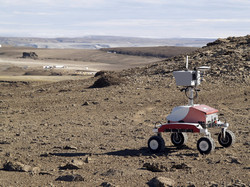Planetary rovers gain speed
In planetary exploration missions, robotic rovers venture into a vast and highly varied terrain with only limited previous knowledge of its trafficability. Based on sparse remote sensing data, estimates are sometimes inaccurate. As a result, rovers may find themselves stuck in a stretch of soft sand or collide with unforeseen obstacles. In the project FASTER (Forward acquisition of soil and terrain for exploration rover), an EU-funded consortium of six partners from five countries developed and demonstrated new technology for efficient acquisition of soil properties on a planet's surface. To avoid accidents, planetary exploration rovers today move slowly, covering only a few metres per day. The FASTER system combines light-weight portable soil sensors with a small all-terrain scout rover that can relatively quickly and more efficiently assess the trafficability of a terrain. Data from the in-situ physical examination of the planetary surface can help the mother rover increase travel speeds while reducing the risk of mishaps. Different soil sensor systems were investigated for the small scout rover: a belly camera, a motor monitor, a ground penetrating radar, a dynamic plate and a penetrometer. The primary rover would have its own sensors for additional data as well as safety should the scout rover fail. Locomotion of the scout rover was also addressed. To provide high traction on soft soil, FASTER proposed a hybrid legged-wheel locomotion system that combines the benefits of wheeled and walking systems. Moreover, the interaction with the deformable terrain was modelled for this type of scout mission to become a reality. The new FASTER system was conceived keeping the requirements of the future Mars Sample Return mission in mind. FASTER partners realised that the successful acquisition of samples from this mission should be supported by a system capable of estimating actual soil properties as the rover traverses the planned path. The concepts and technologies developed in the FASTER project were presented to the EU, European Space Agency (ESA) and National Aeronautics and Space Administration (NASA) officials at a dedicated demonstration event, held on 23 October 2014 in the United Kingdom.







